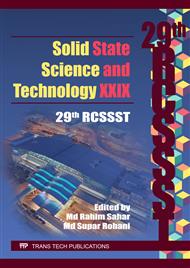p.219
p.224
p.229
p.234
p.239
p.244
p.249
p.254
p.259
Luminescent Properties of SiC Thin Film Deposited by VHF-PECVD: Effect of Methane Flow Rate
Abstract:
Bulk silicon carbide (SiC) as light emitter is less efficient due to its indirect bandgap. Therefore, nanosized SiC thin film fabrication approach enable emission wavelength shifts due to spatial confinement. The result of luminescent study of SiC thin film deposited via very high frequency plasma-enhanced chemical vapour deposition (VHF-PECVD) are presented. Precursor gasses used were silane and methane. Methane flow rate was varied from 8 sccm to 20 sccm while other parameters were maintained. Raman spectral analysis denotes the quantum confinement effect occurrence in proportion to the methane flow rate increment. The luminescence properties of the deposited SiC thin film ranging from highly green emission (~518 nm) to highly UVB emission (~294 nm) dominant luminescence. Broad blue emission band shifted toward higher wavelength with smaller FWHM as methane flow rate is increased. This results enable the possibility of luminescent SiC thin film applications in photonics and electronic integration as blue light sources.
Info:
Periodical:
Pages:
239-243
Citation:
Online since:
October 2017
Keywords:
Price:
Сopyright:
© 2017 Trans Tech Publications Ltd. All Rights Reserved
Share:
Citation:


